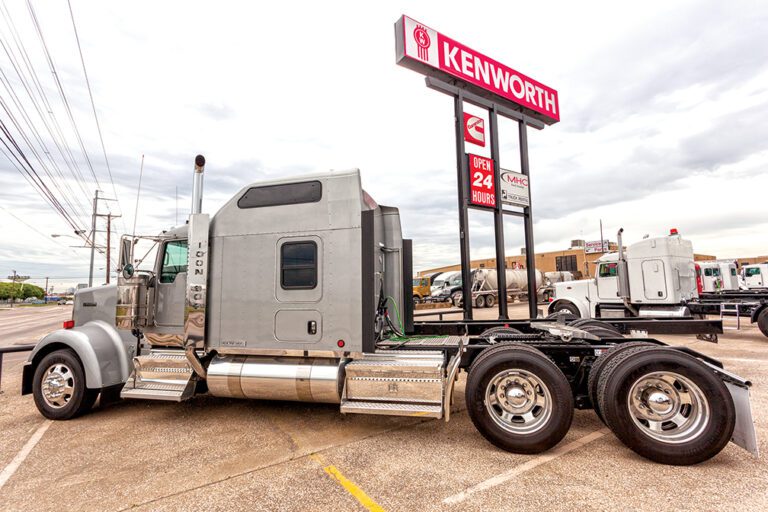U.S. sales of new Class 8 trucks in July were higher than in the same month of 2022, according to information received from Wards Intelligence. Manufacturers reported U.S. sales of 21,021 units in July, the lowest total since February but still up 2.5% from the same month of 2022. If the trend continues, August could mark the first time in 2023 that monthly sales were lower than in the same month last year.
Compared to June sales numbers, 3,064 fewer trucks were sold, a decline of 12.7%. For the year to date, manufacturers have reported sales of 156,864 Class 8 trucks on the U.S. market, up 18.1% (23,797 units) from the same point in 2022.
Early projections for 2023 predicted sales would fall off as the economy entered a recession and freight rates bottomed out. Those projections have mostly been revised, with the recession delayed (if it occurs at all), and truck sales remaining strong.
Orders for new Class 8 trucks in July were anticipated to top 16,000, exceeding orders in July 2022 by 45%. Typically, July is a slow month for orders because manufacturers are closing their books for the current model year and have yet to start taking orders for the next one.
“July is the traditional low-water mark for monthly order placements,” said Kenny Vieth, president and senior analysts at ACT Research. “2024 orderboards are not yet, or just barely open, making the opportunity for bigger numbers elusive.”
Eric Starks, chairman of the board at FTR Intelligence, commented. “We had expected net orders to fall below 10,000 units monthly several months ago as fleets wait for OEMs to open 2024 build slots, but that did not occur.”
The used Class 8 market declined in sales volume from June numbers by 4%, according to ACT’s “State of the Industry: U.S. Classes 3-8 Used Trucks,” but other numbers were favorable to prospective buyers. Compared with July 2022, sales have increased by 34%, due at least in part to greater used truck inventory. At the same time, the average price of a used Class 8 truck has fallen 28%, and average miles and age have also fallen. That’s good news for buyers who have been waiting for the market to loosen up.
One factor that will impact truck markets in some way is the bankruptcy of Yellow Corp. The company’s website sports the claim that it was the fifth-largest transportation company in the U.S., handling 90,000 freight shipments daily. While negotiations continue for financing to allow continued operation at the time of this writing, it’s certainly possible other carriers could purchase part or all of the company’s assets, including trucks, and continue at least a part of the business.
Unless and until that happens, however, Yellow customers must look elsewhere for their shipping needs. Carriers that get that freight will need more trucks and trailers to handle it, resulting in more pressure on manufacturers to keep the assembly lines going. Carriers who acquire more pick-up and delivery routes may turn to irregular-route carriers for some of the linehaul operations, increasing their need for equipment and drivers.
Drivers might also be at a premium for some carriers that are trying to pick up additional business. While an estimated 22,000 former Yellow drivers may be in the market for new jobs, most will be competing with non-union drivers for available positions.
As for the individual OEMs, Freightliner led the way once again with sales of 7,610, down 15.4% from June’s 8,991 and down 3.1% from sales of 7,855 in July 2022. For the year to date, the company has sold 20.5% more trucks than at the same point in 2022.
Volvo sales of 1,944 slipped 19.1% from June sales of 2,403 and were down 8.4% from sales in July 2022. Year to date, the company is up 3% from July last year, the smallest increase of any of the major manufacturers and far below the industry average of 18.1%.
Volvo sibling Mack Truck sold 1,336 trucks on the U.S. Class 8 market in July, a decrease of 21.7% from June but 5.5% better than June 2022. Year to date, Mack is outperforming the market with a 19.7% increase over sales at the same point last year.
International’s 3,039 sold in July was a decrease of 11.3% from June’s 3,426 but was a blistering 36.3% improvement over June 2022 sales numbers. Year to date, the company is 6,516 trucks (41.6%) ahead of last year’s pace. July was the fifth consecutive month of U.S. sales over 3,000 units for International.
Kenworth reported sales of 3,026 in July, down 13.8% from June sales and down 1.3% from July 2022. Year to date, the company has sold 21,745 Class 8 trucks on the U.S. market, up 14.6% from last year’s pace. Peterbilt, the other PACCAR OEM, reported sales of 3,325 in July, up 2.5% from June but down 2% from July 2022. Year to date, Peterbilt’s 22,121 leads Kenworth and is 7.7% ahead of last year.
Western Star sold 681 Class 8 trucks in July, a decline of 7.2% from June sales of 734 but 23.4% ahead of July 2022 sales. Year to date, they are 12.7% ahead of sales at the same point last year. The company is on pace to top annual sales of 7,400 for the first time since being acquired by Freightliner in 2000 (and possibly in its history).
The 2023 market share breakdown shows Freightliner in the lead with 38.6% of reported U.S. sales, followed by International with 14.1%. Peterbilt also shows 14.1% but, with 63 fewer trucks sold, trails International by four-hundredths of a percentage point. Kenworth is close at 13.9% of reported sales, followed by Volvo with 9.8% and Mack with 6.6%. Western Star, even with its great year, is at 2.8% of the market, and Tesla, just getting started with sales, has cracked 0.1% of the market with sales of 195 for the year.
Expect Class 8 truck sales to remain strong for the remainder of the year.
Cliff Abbott is an experienced commercial vehicle driver and owner-operator who still holds a CDL in his home state of Alabama. In nearly 40 years in trucking, he’s been an instructor and trainer and has managed safety and recruiting operations for several carriers. Having never lost his love of the road, Cliff has written a book and hundreds of songs and has been writing for The Trucker for more than a decade.














